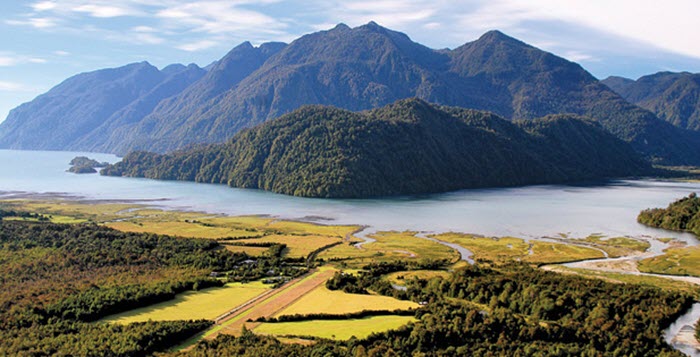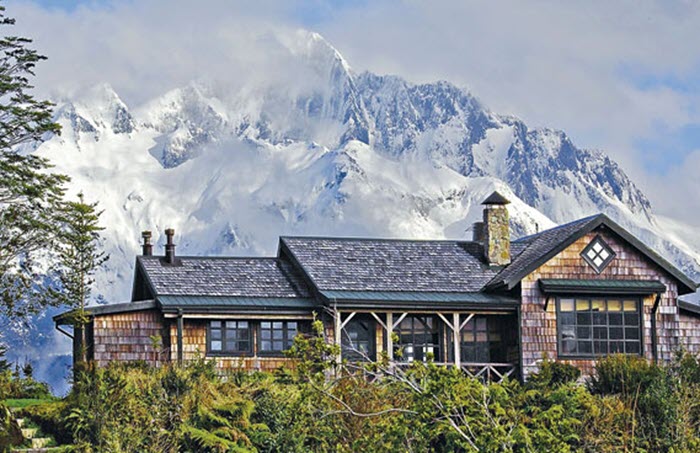This is a great story from my friend Geoffrey McRae at Gateway to South America.
The philanthropist talks about her battle to protect the wilds of Chile and Argentina.
Sometime in the southern hemisphere summer of 1990, Kristine McDivitt, then CEO of the Californian outdoor-apparel company Patagonia, took “a bunch of new executives” to Argentina to show them the terrain its clothing was designed to weather. It was a chance to “imbue them with the company’s ethos and spirit”.
There, in the middle of nowhere, she ran into Douglas Tompkins, co-founder of the rival outdoor-gear company The North Face and, after he had sold it, the global fashion brand Esprit. He had resolved to sell his share of Esprit and his art collection (which included works by Francis Bacon, Balthus, Hopper, Léger and Picasso) so as to devote his considerable wealth to environmentalism.
McDivitt, who turned 40 that year, was tired of corporate life too. She’d first met Yvon Chouinard, the mountaineer who went on to found Patagonia when she was 15. He’d rented the beach house next door to her family’s; she’d “tried to teach him to skimboard”. When she graduated high school, he offered her a summer job at his company, which made mountaineering equipment; after graduating from college she went back to work for him full-time. In 1973 it diversified into outdoor wear. “I’d never had another job,” she tells me. “I’d never had an interview. And the thought that I could be sitting in the same seat when I was 40, 50, 60, maybe even 70… I knew I wanted something else. I just wasn’t sure what.”
She and Doug had met before. “He was a climber,” she tells me. “My first husband was a climber. Yvon was a climber. It was a small tribe.” This time, a spark ignited. “We fell in love and that was that. It changed both our lives and started our conservation work.” That ongoing project has protected and, in some places, rewilded more than 5.7m hectares of land, enabling the creation of 11 new national parks in Chile and Argentina and the expansion of several others. Their donations amount to the largest gift of land in history, projects on which they and private supporters have spent $350m.
We meet in London, where Tompkins has come to give a talk on her work, having flown from New York where she was speaking at an event during the UN General Assembly. Girlishly dressed in a cotton skirt, cardigan and flats, she has the slightness, stature and steel-core air of a ballerina. Doug always called her Birdy, and there is indeed something bird-like about her. “Kris is like a migratory species,” an aide had answered when I’d asked where she lives. She is flying back to Chile the next day. Is she always on the move?
“More than I’d like at the moment,” she replies. “For the past 26 years, we’ve lived wherever the projects are [mostly in Patagonia]. But I’m a nester. Nobody believes it but I am. I don’t do well hopping around but that’s been our life. And since Doug died” – in 2015, from hypothermia following a kayaking accident – “I’ve put up with it because we’ve had all these projects, which I love.” As the land they acquired and have worked to conserve has returned to public ownership, she’s been spending more time on the ranch in California’s Ventura County where she grew up.
“I couldn’t imagine living there,” Tompkins confesses. “I come from Southern California, where the temperature is between 68 and 72 degrees and it almost never rains.” In this part of Chile, the winters are bitter and the average rainfall is 1,942mm a year. There were also no roads. “You either had to come in by boat down a fjord or fly in [Doug had a Cessna] in vicious weather.”“Doug was the draw,” she stresses about her move to South America after their marriage in 1994. He had found a farm in Chile situated “at the toe of a fjord that cost what a garage would cost in San Francisco”. The asking price was $35 a hectare: there were 17,000 ha of temperate rainforest. He bought the lot for $600,000.
The farmhouse at Fundo Reñihué was uninhabitable so the Tompkinses lived in the former smokehouse, a space of “barely 100sq ft”, Tompkins says. “We were really dependent on each other for everything. But you know when you’re in love, and everything’s fabulous, so it didn’t matter. In fact, when the house that became our base was ready” – in its final permutation an infinitely photogenic five-bedroom property with an organic farm that she sold two years ago (Sotheby’s asking price: $10.5m) – “I didn’t want to move in. I was very happy in the smokehouse.”
Regardless, it was the land that mattered. As more adjoining parcels became available, they acquired them, careful never to purchase areas where people lived and buying mostly from absentee owners (during the 1930s, foreigners were offered land for rent or concessions if they were prepared to settle in Patagonia, and many families had retained but no longer occupied their estates). In 2007 they donated 294,000ha to the Chilean State to create what was posthumously renamed Pumalín National Park: Douglas R Tompkins. Today its area extends over 402,392ha of northern Patagonia and protects a fifth of all the alerce trees – a relative of the redwood – in Chile, as well as puma, pudu (a kind of deer) and monito del monte, a rare marsupial.
In the early days, they faced considerable hostility. “We were completely vilified,” she says. “Pumalín goes from the Argentine border to the Pacific Ocean so we were known as ‘the couple who cut Chile in half’.” And it went downhill from there. “We were creating a new Jewish state – although we were raised as Anglicans; a nuclear waste site for the United States; a base camp for the Argentine military so they could finish Chile off once and for all. There were a lot of death threats. We had military planes flying over where we were based. Our phones were tapped for five years. At the time it was frightening. But when I look back on it, it seems very reasonable to me. Foreigners coming to buy up huge amounts of land and do nothing with it – of course, there was tremendous scepticism, so I don’t really worry about that any more.”
In any case, their intention was never to keep the land. “Our work was based on leveraging. We’re a family foundation, but we saw early on that to really go after large-scale conservation we needed to leverage every dollar that we invested” by persuading the government to provide, protect and manage adjacent land. So when acquiring estates, “we always looked at what was next door”. In that respect, Tompkins believes their combined business background was helpful. “It gives you a kind of discipline and viciousness about results that some NGOs or foundations don’t have.” It also taught her to manage a large staff: at its peak, Tompkins Conservation employed “up to 350 people, though now that we’ve donated everything it’s shrunk a lot in the past year”.
But, she stresses, “none of this would have been achieved without the [governments of Chile and Argentina] wanting it as badly as we did.” Over the past 25 years, she has worked with 10 presidencies. “You can’t donate something that a country doesn’t want to accept. And people forget that it’s not always politically beneficial to a president to declare a new national park. Without [Ricardo] Lagos, without [Michelle] Bachelet – she was extraordinary! – without [Sebastian] Piñera” – the Chilean president, to whom she presented a Global Citizenship award at the UN General Assembly in September – “there would have been no national park creation. That award was a salute to the entire country.”
The most recent park she was instrumental in creating is Parque Patagonia, which covers more than 300,000ha, 27 per cent of which was donated to the Chilean government last April. It, too, was initially controversial. “There was a lot of suspicions, and downright unhappiness, about Chile’s third-largest sheep ranch becoming a park,” she says. “We’d never bought land with livestock on it, and this made it so contentious. By the time we closed on the deal, we had 25,000 sheep worth $1m, so all of a sudden we’d become ranchers.”
Tompkins ran the ranch for 14 years. “Doug saw this as my project. So I made a business plan, figured out how to maximise the investment. And that helped fund the transition of what became the national park. You have to be really cautious [selling that much livestock]; you don’t want to have a negative impact on the meat and wool markets.”
If Pumalín is about trees, Parque Patagonia is about landscape and wildlife – notably a rare deer, the huemul, Chile’s national animal, which was facing extinction but whose numbers are rising again. Once the sheep were gone, and with them, 600km of fencing, herds of guanaco – related to the llama – returned to the valley. A casualty of their return has been the roses Tompkins cultivated in the garden of the lodge they built: “I’m fighting with them over that. I say, ‘You have 750,000 acres. Leave the roses alone!’ But they don’t listen.” She puts their present number at about 3,000, which in turn has positively affected the puma population.
At Estancia Iberá, meanwhile, a reserve of almost 20,000ha in northern Argentina purchased in 2000, they are proactively rewilding – a term, incidentally, Tompkins reckons they coined – by bringing back species that had died out there completely. “[Rewilding] is not for the faint at heart,” she says. “It’s very costly and very complicated. You have to make sure the threats that extinguished them in the first place no longer exist. And though we have had great victories, when something goes wrong you lose animals.” And that, she says, hurts.
But the giant anteaters they’ve brought back are now thriving, as are white-collared peccaries and pampas deer. Indeed, having worked up to the apex predators, the focus now is the jaguar, a species hunted to extinction in the Iberá wetlands in the 1930s. Three are due to be released in January. Lately, Tompkins Conservation has diversified into the oceans, too, creating two parks covering 260,000sq km “at that junction between the Atlantic, the Pacific and the Antarctic”, where fishing is now banned completely. But ultimately, it’s the future of the planet that concerns her.
“I’m going to die of old age,” she says. “You probably will as well. But young people are going to die of climate change. It’s not that we haven’t known that, but boy oh boy: that gives you another perspective, a reason to get out of bed.” And that is why she puts her money where her mouth is. Because every hectare that Tompkins protects sequesters carbon, which is at least a step towards mitigating global warming.
“As much as I miss Doug, and [his death] almost killed me, sometimes I pinch myself that I’ve led this life for so long. Even on the worst days, I love what I’m doing. Imagine the percentage of people who can say that, who can’t wait to get out of bed because even when things are rotten, you know you’re on the right track. Even in the worst of the worst of the worst times, you’re on the right path. You’re doing what you want to do. That’s a gift.”
Source: FT


